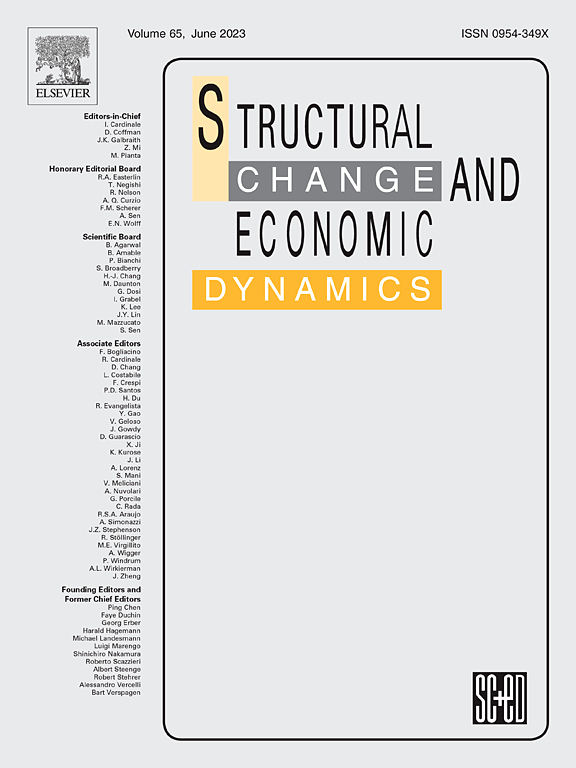二氧化碳排放峰值取决于经济规模和产业结构的变化
IF 5.5
2区 经济学
Q1 ECONOMICS
引用次数: 0
摘要
达到二氧化碳(CO2)排放峰值是实现碳中和的先决条件。大多数发展中国家对如何实现二氧化碳排放峰值感到困惑,而其他国家则不确定最近的二氧化碳排放拐点是否代表真正的峰值。本研究从社会经济发展的角度确定了二氧化碳排放峰值的决定因素和数值范围,并进一步建立了区分真假二氧化碳排放峰值的标准。本文采用主成分分析和面板阈值回归模型,研究了1960 - 2016年16个碳排放峰值发达国家社会经济因素对二氧化碳排放的非线性动态影响。研究结果表明,以经济规模和产业结构为特征的经济子系统对二氧化碳排放产生非线性阈值效应,通过塑造峰值总量和峰值时间,在二氧化碳排放峰值过程中起主导作用,并成为区分真假峰值的关键因素。确定的标准是:国内生产总值增长率在1.20%至4.94%之间,人均国内生产总值在18519美元至44597美元之间,第三产业产值占国内生产总值的比重在51%至65%之间。这三个关键指标必须同时得到满足,才能达到真正的二氧化碳排放峰值。本研究结果不仅有助于科学、准确地识别CO2排放峰值,也为尚未达到峰值的国家或地区制定和完善实现CO2排放峰值的经济发展战略提供了宝贵的参考。本文章由计算机程序翻译,如有差异,请以英文原文为准。
Carbon dioxide emissions peaks depend on changes in economic scale and industrial structure
Reaching carbon dioxide (CO2) emissions peak is a prerequisite for achieving carbon neutrality. Most developing countries are puzzled about how to achieve CO2 emissions peak, whereas other countries are uncertain whether the recent inflection points in CO2 emissions represent genuine peaks. In this study, we identified the decisive factors and numerical ranges for peaking CO2 emissions from a socioeconomic development perspective, and we further established the criteria for distinguishing between genuine and spurious CO2 emissions peaks. By employing principal component analysis and the panel threshold regression model, in this study, we investigated the nonlinear dynamic impacts of socioeconomic factors on CO2 emissions in 16 developed countries with peak emissions during the period from 1960 to 2016. The results demonstrate that a nonlinear threshold effect is exerted by the economic subsystem, characterized by economic scale and industrial structure, on CO2 emissions, thus playing a predominant role in the peaking process of CO2 emissions by shaping both the total amount and the timing of reaching the peak, and emerging as the key factor in distinguishing between genuine and spurious CO2 emissions peaks. The identified criteria for this distinction are as follows: a gross domestic product (GDP) growth rate of between 1.20 % and 4.94 %, a GDP per capita ranging from USD 18,519 to USD 44,597, and the ratio of tertiary industry output value to the total GDP falling within 51–65 %. All three key indicators must be simultaneously satisfied to fulfill the criteria to achieve a genuine CO2 emissions peak. The findings of this study not only facilitate the scientific and precise identification of the CO2 emissions peak but also provide invaluable references for countries or regions that have not yet reached their peaks in formulating and refining economic development strategies to achieve CO2 emissions peak.
求助全文
通过发布文献求助,成功后即可免费获取论文全文。
去求助
来源期刊

Structural Change and Economic Dynamics
ECONOMICS-
CiteScore
9.60
自引率
4.90%
发文量
159
期刊介绍:
Structural Change and Economic Dynamics publishes articles about theoretical, applied and methodological aspects of structural change in economic systems. The journal publishes work analysing dynamics and structural breaks in economic, technological, behavioural and institutional patterns.
 求助内容:
求助内容: 应助结果提醒方式:
应助结果提醒方式:


